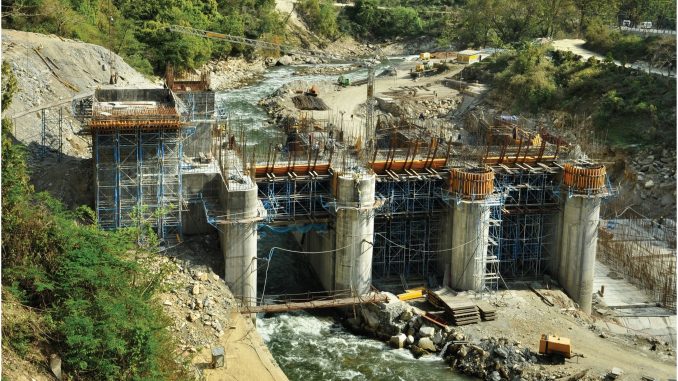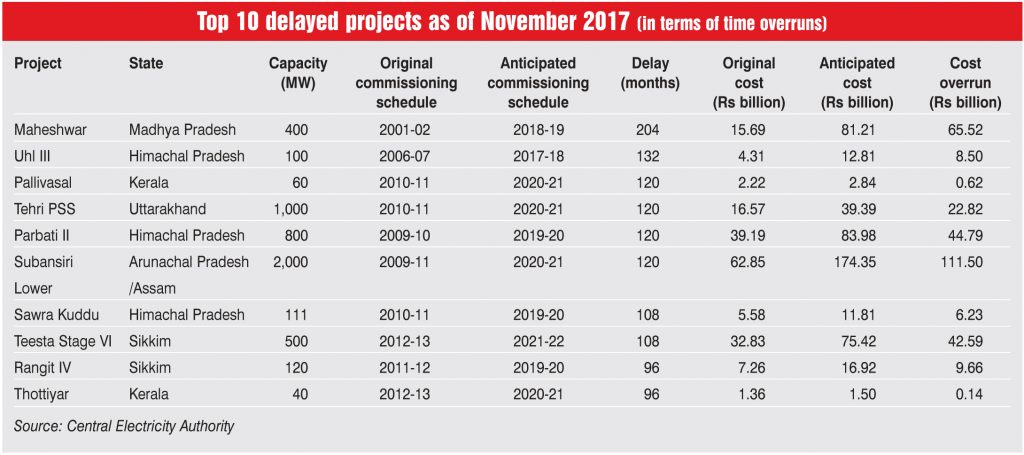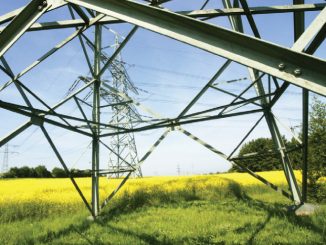
The hydropower segment in India has consistently fallen short of achieving the prescribed capacity addition targets every year since 2008-09. During the Twelfth Plan period (2012-17), around 5,479 MW of capacity was added against the targeted addition of 6,247 MW. In 2017-18, about 278 MW of hydro capacity has been added till October 2017 against the annual target of 1,305 MW. The low capacity addition can be attributed to delays in land acquisition, resettlement and rehabilitation (R&R) issues, lengthy environmental approval processes and geological surprises that hamper project development. As per the Central Electricity Authority (CEA), around 38 hydropower projects aggregating 11,650.5 MW are facing delays with significant time and cost overruns, as of November 2017.
Causes of delay
Delays have become commonplace in the hydropower sector due to land acquisition challenges, long gestation periods and R&R issues. However, the biggest impediment to project commissioning remains the multitude of clearances and approvals required. In addition, weather fluctuations often slow down the pace of work, thereby aggravating the problem. Further, rehabilitation concerns amongst local communities and subsequent agitations continue to act as roadblocks in the commissioning of hydropower projects. In addition, most new hydropower sites are located in remote hilly areas with little or no infrastructure facilities such as roads, thus making the transport of men and machinery difficult. Apart from these, issues pertaining to water sharing between states, geological factors and delays in the award of contracts have been responsible for commissioning delays, which have exceeded 10 years in some cases.
Time overruns
The average time overrun of hydropower projects is estimated at six years, which is considerably long considering the steps being initiated by the government to provide an impetus to green projects in the country. As per the CEA, seven projects are facing delays of 10 years or more (as of November 2017). Of these, the 400 MW Maheshwar hydroelectric project (HEP) in Madhya Pradesh has had the highest time overrun of around 17 years. The primary concern of the Maheshwar HEP is the R&R of the local communities that are likely to get displaced as a result of its construction. The project has faced strong resistance from the Narmada Bachao Andolan in the past. Further, the project promoter, Shree Maheshwar Hydel Power Corporation Limited, has been facing financing issues, which also led to the takeover of the company’s control by lenders in 2016. The project is currently stalled.
Meanwhile, NHPC Limited’s 100 MW Uhl III HEP in Himachal Pradesh has been held up for 11 years due to delays in the transfer of forest land and the award of contracts, and the poor structure of the head race tunnel. North Eastern Electric Power Corporation Limited’s 60 MW Tuirial project in Mizoram was commissioned in November 2017 after being delayed by 11 years due to challenges such as poor approach roads, slope failures and agitation from local communities. Other projects facing delays of nearly 10 years include THDC India Limited’s 1,000 MW Tehri pumped storage project in Uttarakhand, NHPC’s 800 MW Parbati II in Himachal Pradesh and 2,000 MW Subansiri Lower in Arunachal Pradesh. Several other projects are facing delays ranging from five to nine years.
Cost overruns
Due to the cost-intensive nature of hydropower projects and unanticipated contingencies, the cost overruns of these projects are also significant. Since hydropower projects are financed by a huge amount of debt, project delays lead to significant cost escalation on account of the interest component of the loan. The interest during construction is calculated till the time the project gets commissioned and starts generating revenue. The process of obtaining clearances from several authorities and various geological factors such as floods and landslides lead to delays in project commissioning, thereby increasing the duration for which interest is calculated and the overall project cost.
Most hydropower projects under construction have experienced cost overruns with an average breach of about Rs 18.5 billion. Of the delayed projects, 23.07 per cent have registered cost overruns exceeding Rs 36.5 billion. Further, four projects have witnessed exceptionally high cost overruns accounting for 54.71 per cent of the total cost overshoot. These are the Subansiri Lower HEP, Maheshwar HEP, Parbati II HEP and Teesta Stage VI HEP (500 MW) with cost overruns of Rs 111.49 billion, Rs 65.51 billion, Rs 44.79 billion and Rs 42.58 billion respectively.
The quantum of capacity in the pipeline indicates that the country stands to gain from its huge hydropower potential. However, the government is required to play a proactive role in enabling the stakeholders to exploit this potential. The probable inclusion of this sector in the renewable segment has the potential to revive these projects and expedite the process of commissioning them as per stipulated timelines.
In addition, there is a need to draft objective criteria for the award of clearances and create a single-window clearance system. A single clearance window is important to reduce the cost and time overruns by a considerable margin. This will not only lead to significant capacity addition in a short span of time, but will also encourage developers to undertake projects and make investments in this sector.
Besides, incentives and disincentives should be provided for timely completion. For instance, return on equity can be linked to the completion schedule (16.5 per cent for timely completion and 0.5 per cent reduction per year of delay). Appropriate risk sharing mechanisms must be in place to address delays encountered due to geological surprises. In addition, there is a need to engage with local communities in order to understand their concerns and provide incentives to avoid protests against the projects. Further, firm contractual guidelines should be in place prior to the start of the project.
With adequate policy and regulatory support, hydropower projects can go a long way in reducing the regional disparities in power supply and alleviating the sector distress.




